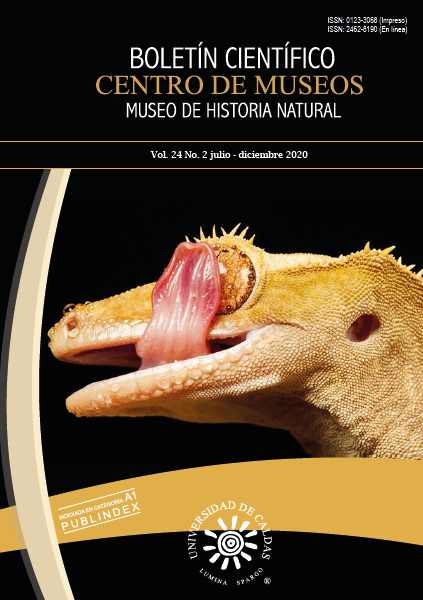Authors
Abstract
Colombia has approximately 1700 species of lichens of which 1396 are in the Andean region, indicating that it is an area with a large concentration of lichen richness, even so in that region there are not many studies carried out under 2000 masl and taking into account that the urban growth has consequences on the diversity of these so it is important to generate information. In this work the diversity of lichens was characterized in green areas of Ibague city. A 10 x10 cm template was used following Iwatuski method (1960) to measure the coverage area in four type of substrate (bark, rock, cement and trunks) and get the abundance, there were collected 731 individuals for 35 species of which 16 are new registers for Ibague city and 5 new reports for Tolima. The abundance was evaluated in different substrates; the bark presents the greatest amount of coverage with 91.2% followed by rock (6.6%), wood (1.7%), cement (0.5%). There were evaluated the diversity index of Shannon, richness index of Margalef and dominance index of Simpson; the greatest diversity is found in bark. The greatest richness in rock and the greatest dominance in cement. This work contributes to the knowledge of lichens in Colombia and it generates the first dichotomous key of lichens in green areas of Ibagu
Keywords:
References
Benavides, J. (2004). Líquenes y Briofitos del Área Metropolitana de Bucaramanga. Universidad Industrial de Santander. P. 53-103.
Brodo, I.; Duran, S. & Sharnoff S. (2001). Lichens of North America. Yale University Press/New Haven and London. 795 pp.
Canseco, A. y Franken, M. (2006). Comunidades de líquenes: indicadores de la calidad del aire en la ciudad de La Paz, Bolivia. Acta Nova 3: 286-307.
Cerón, B. y Quintero, A. (2009). Estructura de una comunidad de líquenes y morfología del género Sticta (Stictaceae) en un gradiente altitudinal. Acta Biológica Colombiana, 14(3), 157-170.
Chaparro, M. y Aguirre, J. (2002). Hongos liquenizados. Colección textos. Universidad Nacional de Colombia.
Enzensberg, H.M. (2000). Los líquenes “El más lento telegrama de la tierra”. Disponible en: http://es.geocities.com/ecored2000/liquen.html. Pp 1-6.
Gries, C. (1999). Lichens as indicators of air pollution. En: T.H. Nash III (eds). Lichen biology: 240-254. Cambridge UniversityPress, Cambridge.
Esquivel, H. E., y Vivas, A. N. (2003). Diversidad florística de la cuenca alta del río Combeima. Proyecto Servicios Integrados para Jóvenes.
Hortal, J. & Lobo, J.M. (2002). Una metodología para predecir la distribución espacial de la diversidad biológica. Ecología, 16, 405-432.
Iwatzuki, Z. (1960). The epiphytic briophyte communities in Japan. Journal of the Hattori Botanical Laboratory 22: 159-339.
Jara, M.U. (1991). Ramalina (Lichens) en los parques de Lima. Espacio y Desarrollo, (3), 29-39.
Lavornia, J.M.; Kristensen, M.J. y Rosato, V.G. (2016). Clave de identificación de líquenes saxícolas Del Paisaje Protegido “La Poligonal” (Sistema de Tandilia, Buenos Aires). Revista del Museo Argentino de Ciencias Naturales, 18(2), 107-115.
Lawrey, J.D. (1984). Biology of lichenized fungi. Praeger.
Lindenmayer, D.B. & Franklin, J.F. (2002). Conserving forest biodiversity: a comprehensive multiscaled approach. Island Press.
Moreno, C.E. (2001). Métodos para medir la Biodiversidad. Volumen I. Manuales y Tesis. Sociedad Entomológica Aragonesa. Zaragoza, España. 84 pp.
Pacheco, M.L. (2016). Estudio de la preferencia de hábitat de Cladonia confusa y Leptogium azureum, líquenes muscícolas en un fragmento de bosque alto-andino, en la reserva biológica el Encenillo, Guasca, Cundinamarca. (Tesis de pregrado). Pontificia Universidad Javeriana, Facultad de Ciencias, Bogotá.
Pinzón, M. & Linares, E. (2006). Diversidad de líquenes y briofitos en la región subxerofítica de la Herrera, Mosquera (CundinamarcaColombia). Riqueza y Estructura Richness and Structure. Caldasia, 28(2), 243-257.
Rangel, J. (2015). La biodiversidad de Colombia: significado y distribución regional. Revista de la Academia Colombiana de Ciencias Exactas, Físicas y Naturales, 39(151), 176-200.
Rincón, A.; Aguirre, J. y Lücking, R. (2011). Líquenes corticícolas en el Caribe Colombiano. Caldasia, 33(2), 331-347.
Rubiano, L. (1983). Líquenes como indicadores de Contaminación en el Complejo Industrial de Betania y la Termoeléctrica de Zipaquirá, Cundinamarca. Acta Biológica Colombiana 1: 95-125.
Simijaca-Salcedo, D.F.; Vargas-Rojas, D.L. & Morales-Puentes, M.E. (2014). Uso de organismos vegetales no vasculares como indicadores de contaminación atmosférica urbana (Tunja, Boyacá, Colombia). Acta Biológica Colombiana, 19(2).
Soto, E.; Londoño, V. & Díaz, D (2015). Epiphytesfrom a forest type transition zone in the Choco Biogeographic Region, Valle del Cauca, Colombia. Revista de Biología Tropical, 63(4), 915-926.
Wolf, J. (1993). Diversity patterns and biomass of epiphytic bryophytes and lichens along an altitudinal gradient in the northern Andes. Ann. Mo. Bot. Gard. 80: 928-960.

 pdf (Español (España))
pdf (Español (España))
 FLIP
FLIP
 Perfil Google Scholar
Perfil Google Scholar



















